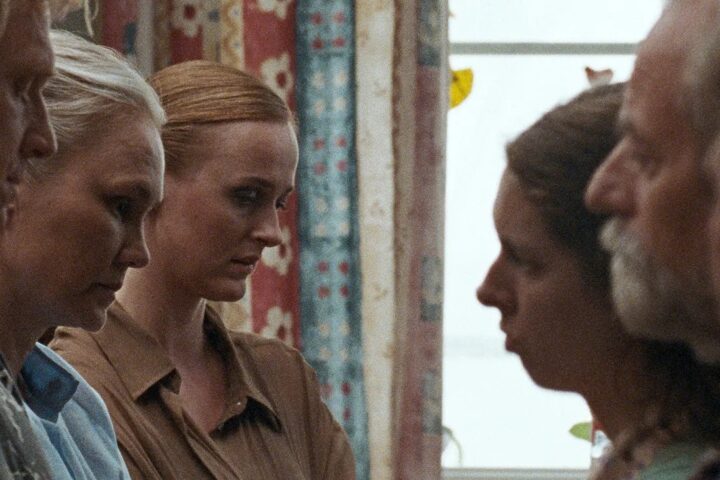At the outset of Paolo Sorrentino’s Parthenope, a young woman gives birth in the Mediterranean Sea while her son looks on from the beach. “Let’s call her Parthenope,” the newborn’s godfather triumphantly bellows as he gestures toward Mount Vesuvius, invoking the mythological siren who lent the city of Naples its original name.
Though there’s no clear allegorical parallel between the myth and the story that Sorrentino will leisurely spool out, the connection between the title character and the land of her birth makes explicit the film’s thematic agenda. As much a city symphony as was Sorrentino’s 2013 Roman odyssey The Great Beauty, Parthenope presents itself as a meditation on youth, beauty, and the passage of time but finally unfurls as an ode to Naples itself—the director’s own birthplace, and likewise the setting for his autobiographical The Hand of God from 2021.
“It is impossible to be happy in the most beautiful place in the world,” says Parthenope’s brother, Raimondo (Daniele Rienzo), now a young man in 1968. Naples may not be the most beautiful place in the world, but the way Sorrentino shoots it, in his typically luminous style, tracing the rocky cliffs with soaring camerawork as the sun glimmers on the sea, it’s hard to refute the point. Of course, it’s not only the allure of the landscape Raimondo laments, but that of his sister (played for most of the film, from age 18 into her late 20s, by Celeste Dalla Porta), whose beauty is described by one character as “disruptive.”
This turns out to be literally true. Restaurants full of people stare at her, frozen in awe. A crew of rowers comes to a standstill in the bay as they gaze up at Parthenope on her balcony; later, a succession of onlookers on shore stop to gawp as she glides by in a kayak. A millionaire in a helicopter constantly hovers, sending his emissary to invite her on a date. And, true to an unfortunate cliché of European art cinema, her brother is clearly in love with her.
For a while, it seems as if Sorrentino is setting up an incestuous, Neapolitan spin on Luca Guadagnino’s Challengers, with Raimondo duking it out with Parthenope’s boyfriend, Sandrino (Dario Aita), for his sister’s affections. But Sorrentino’s film, episodic and essentially picaresque, turns out to be more elusive. If anything, the film is closer to a joyless rendition of Paul Thomas Anderson’s Licorice Pizza, as it, too, is a chronicle of a young woman listlessly following various whims while she tries to find out what the hell she wants to do with her life.
She starts out at university, pursuing an anthropology degree under the tutelage of the disaffected Professer Marotta (Silvio Orlando, whose droll performance is the highlight of the film). But after a talent agent approaches her in a restaurant, she pivots toward a possible career as an actress. This foray, which involves encounters with an eccentric acting teacher (Isabella Ferrari) and an embittered, aging starlet (Luisa Rainieri), ultimately proves a dead end. Parthenope returns to academia to finish her thesis on “the cultural frontiers of the miraculous,” which eventually leads to an invitation to observe the Miracle of San Gennaro.
“What is she thinking?” is a question posed repeatedly by different characters, and it’s one that the film willfully refuses to answer until the very end, when Parthenope, now at the age of retirement and played by the great Stefania Sandrelli, reflects on her youth and we are granted access to a brief internal monologue. But it’s not a moment that reveals much about what we’ve seen up to this point. Parthenope remains nearly as inscrutable to us as she is to the people in her orbit, who get drawn in by her physical charms but, with the exception of Professor Marotta, are insensible to her intellectual qualities. What’s more, any poignancy in seeing Sandrelli embody Parthenope in her later years stems primarily from our association with the real-life actress’s lengthy career, rather than any real emotional investment in the character.
Sorrentino’s reluctance to explicate extends beyond his protagonist. The world of Parthenope is filled by a number of period-specific details that, stripped of narrative context, lead to sequences of transcendent surrealism. A funeral procession stops when a truck spraying disinfectant from its spidery tubing system blocks the road; there’s a cholera outbreak, we’re told, and it’s never mentioned again. Later, we see Parthenope weeping on the steps of the university as a political riot breaks out in oneiric slow-mo, but the precipitating political situation is never clarified. As he did in The Hand of God, Sorrentino enlarges what could otherwise have been an insular catalog of memories, using the particular to access the metaphorical.
Frequently, despite Sorrentino’s formal brilliance, which extends from his musically intuitive editing style to his numinous lighting schemes, the film’s succession of symbolically loaded vignettes is less meaningful than intended. Whether satirizing academic jargon or religious hypocrisy, which Sorrentino has covered extensively in his earlier work, and especially in moments that edge up to magic realism, the film conveys a portentous tone without having much to say. The pompous grandiosity of Sorrentino’s work is typically offset by his perverse sense of humor, but that’s less the case here than in the past, resulting in a ruinous chasm between what little the film offers intellectually and the self-importance with which it offers it.
Since 2001, we've brought you uncompromising, candid takes on the world of film, music, television, video games, theater, and more. Independently owned and operated publications like Slant have been hit hard in recent years, but we’re committed to keeping our content free and accessible—meaning no paywalls or fees.
If you like what we do, please consider subscribing to our Patreon or making a donation.




